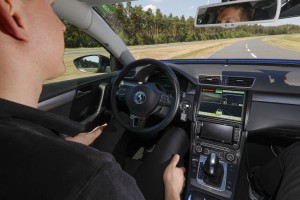
Continental's Cruising Chauffeur is designed to make the transition from autonomous driving mode to an actual person driving easier.
The race to produce automated driving systems is in full swing, drawing high-tech startups, Silicon Valley giants, such as Google and Apple, traditional car makers, like Ford, and old-line suppliers, such as Delphi and Continental.
Not wanting to be left behind as the industry makes the transition to autonomous vehicles, Continental recently unveiled a new product that takes aim at the delicate transition from automation that assists drivers to fully automated vehicles that can actually pilot themselves through traffic under all sorts of conditions.
“The Cruising Chauffeur brings a two-fold benefit when it comes to safety,” said Ralph Lauxmann, head of Systems & Technology in Continental’s Chassis & Safety division, who discussed the new technology features, which include a function that can stop and park the car if the driver is disabled.
“Firstly, automation avoids human error in regular operation while also offering a comfortable ride. Secondly, the Cruising Chauffeur includes an additional fallback mode that conventional vehicles do not have. If the driver is no longer able to take control of the wheel again, for whatever reason, then the Cruising Chauffeur nonetheless brings the car to a stop safely.”
(Autonomous vehicle development gets boost from FCC. Click Here for the story.)
The German tire and technology supplier has been tinkering with bits and pieces of the suite of technology that enables automated driving. It is using experience and data collected since 2012 and to test a fleet of development vehicles in Germany, the United States, Japan and China.
The “Cruising Chauffeur” function gives vehicles the ability to take over the driving task on highways in accordance with the existing national traffic regulations.
Part of the division of tasks between the driver and the vehicle is that the driver takes over driving again at the end of the stretch of the highway. The handover is initiated by a specific interface that is also being tested in the vehicles.
(Click Here for details about Toyota’s $100M investment disruptive tech.)
Even if the driver fails to respond when prompted to take over – for health reasons, for example – the vehicle is able to stop safely with a minimum risk maneuver, in which the vehicle identifies where there is space to stop safely and automatically heads for this place. This function will be part of the Cruising Chauffeur when it is ready for production in 2020.
The Cruising Chauffeur is designed with built-in redundancy so that it can still perform the task of driving even if individual sensors do not work.
In addition to separate networking of different types of sensors, this also includes having a Safety Domain Control Unit as a second automation path Continental engineers explain if automation reaches a control limit or if one type of sensor fails to work for technical reasons, for example, then the minimum risk maneuver kicks in.
(BMW hopes to stay connected with consumers with new BMW Connected +. For more, Click Here.)
There is also a fallback mode to the brake system installed in the vehicle and to the steering as well, the company notes.
